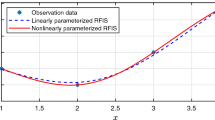Abstract
In a fuzzy classifier, the maping “inputs–output” is described by the linguistic 〈If–then〉 rules, the antecedents in which contain the fuzzy terms “low,” “average,” “high,” and so on. To increase the correctness, the fuzzy classifier is learned by using experimental data. The problems with equal and different costs of various classification errors are discussed. A new criterion is offered for problems with undistinguishable types of errors, in addition to the two known criteria. A new one implies that the distance between the desired and real fuzzy results of classification for the cases of a wrong decision is weighted by the penalty factor. The learning criteria are generalized for problems of classification with the cost matrix. The conducted computer experiments on the wine recognition and heart disease diagnostics problems show that the best quality parameters of tuning fuzzy classifiers are achieved by a new learning criterion.
Similar content being viewed by others
References
Kuncheva, L.I., Fuzzy classifier design, in Studies in Fuzziness and Soft Computing. vol. 49, Berlin: SpringerVerlag, 2000.
Bellman, R., Kalaba, R., and Zadeh, L., Abstraction and pattern classification, J. Mathem. Anal. Appl., 1966, vol. 13, no. 1, pp. 1–7.
Rotshtein, A. and Shtovba, S., Identification of a nonlinear dependence by a fuzzy knowledge base in the case of a fuzzy training set, Cybern. Syst. Anal., 2006, vol. 42, pp. 176–182.
Ishibuchi, H., Nakashima, T., and Nii, M., Classification and Modeling with Linguistic Information Granules: Advanced Approaches to Linguistic Data Mining, Berlin: Springer-Verlag, 2005.
Cordon, O., del Jesus, M.J., and Herrera, F., Genetic learning of fuzzy rule–based classification systems coop erating with fuzzy reasoning methods, Int. J. Intell. Syst., 1998, vol. 13, pp. 1025–1053.
Shtovba, S.D., Proektirovanie nechetkikh sistem sredstvami MATLAB (Fuzzy System Design by MATLAB Means), Moscow: Goryachaya liniya, Telekom, 2007.
Rotshtein, A., Design and tuning of fuzzy rule–based system for medical diagnosis, in Fuzzy and NeuroFuzzy Systems in Medicine, Teodorescu, N.H., Kandel, A., and Jain, L.C., Eds., BocaRaton: CRCPress, 1998, pp. 243–289.
Ishibuchi, H., Nakashima, T., and Morisawa, T., Voting in fuzzy rule–based systems for pattern classification problems, Fuzzy Sets and Systems, 1999, vol. 103, pp. 223–238.
Duda, R.O. and Hart, P.E., Pattern Classification and Scene Analysis, New York: Wiley, 1973; Moscow: Mir, 1976.
Shtovba, S., Pankevich, O., and Dounias, G., Tuning the fuzzy classification models with various learning criteria: The case of credit data classification, Proc. Int. Conf. on Fuzzy Sets and Soft Computing in Economics and Finance, St. Petersburg, 2004.
Rastrigin, L.A., Adaptatsiya slozhnykh sistem. Metody i prilozheniya (Adaptation of Complex Systems. Methods and Applications), Riga: Zinatne, 1981.
Bache, K. and Lichman, M., UCI Machine Learning Repository, http://archive.ics.uci.edu/ml]. Irvine, CA: Univ. Calif., School Inform. Comp. Sci., 2013.
Ishibuchi, H. and Yamamoto, T., Fuzzy rule selection by multi–objective genetic local search algorithms and rule evaluation measures in data mining, Fuzzy Sets and Systems, 2004, vol. 141, pp. 59–88.
Shtovba, S., Ensuring accuracy and transparency of Mamdani fuzzy model in learning by experimental data, J. Autom. Inform. Sci., 2007, vol. 39, no. 8, pp. 39–52.
Breiman, L., Technical note: Some properties of splitting criteria, Machine Learning, 1996, vol. 24, no. 1, pp. 41–47.
Author information
Authors and Affiliations
Corresponding author
Additional information
Original Russian Text © S.D. Shtovba, O.D. Pankevich, A.V. Nagorna, 2015, published in Avtomatika i Vychislitel’naya Tekhnika, 2015, No. 3, pp. 5–16.
About this article
Cite this article
Shtovba, S.D., Pankevich, O.D. & Nagorna, A.V. Analyzing the criteria for fuzzy classifier learning. Aut. Control Comp. Sci. 49, 123–132 (2015). https://doi.org/10.3103/S0146411615030098
Received:
Accepted:
Published:
Issue Date:
DOI: https://doi.org/10.3103/S0146411615030098




